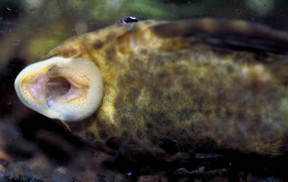Hypostomus plecostomoides
LDA42, LDA38
Classification
Loricariidae. Subfamily: Hypostominae
Distribution
Found throughout the Rio Orinoco drainage in Colombia and Venezuela.
Habitat
It’s usually found living in and around pieces of driftwood in flowing parts of rivers and streams.
Maximum Standard Length
10″ (25cm).
Aquarium SizeTop ↑
48″ x 18″ x 18″ (120cm x 45cm x 45cm) – 243 litres.
Maintenance
A spacious tank is required, preferably with a sandy substrate. Provide hiding places in the form of some big chunks of driftwood (also essential in the diet of the fish, see below), and preferably dim lighting. Aquatic plants are not a feature of its natural waters and would most likely be eaten anyway. Some surface vegetation, however, is not a bad idea. It also needs well-oxygenated water, ideally with a good amount of movement and flow.
Water Conditions
Temperature: 70-81°F (21.0-27.0°C)
pH: 6.5-8.0
Hardness: 5-25°H
Diet
H. plecostomoides is primarily a xylophagus (wood-eating) species and will not do well without access to wood as a food source. In scientific studies the intestines of the fish have found to be completely filled with wood chips and the fish have specialised bacteria in the gut that help with the digestion of it. It also enjoys munching on greenery such as cucumber, courgette, blanched spinach etc. and will also accept sinking dried foods.
Behaviour and CompatibilityTop ↑
An amicable species that can be kept with a variety of tankmates provided its oxygen requirements are met. Larger characins, cyprinids, peaceful cichlids and other catfish would be suitable. It’s surprisingly non-territorial and can be kept both in a species group or with other peaceful Loricariids. Bear in mind that smaller species may be intimidated by its size.
Sexual Dimorphism
Not easily sexed, although mature females appear slightly broader when viewed from above.
Reproduction
Not known to have been bred in the hobby. It spawns in deep holes in river banks during the wet season in nature.
NotesTop ↑
This species is part of the Hypostomus cochliodon complex, all of which were previously included in the genus Cochliodon, which is now considered a synonym of Hypostomus. Members of this group can be distinguished from congeners by several differences in morphology, most notably the hump-backed profile of mature fish and spoon-shaped dentition. These features, along with the fishes tendency to eat wood, are shared with the Panaque genus of the Ancistrinae subfamily, but the two genera are known to have evolved convergently (independently) of one another. It’s thought that the wood-eating behaviour of the fish has developed as they inhabit areas where fallen wood litters much of the substrate. Not much light penetrates the water to initiate algal growth, giving fish with the ability to use wood as a food source a competitive advantage. It’s certainly an impressive specialisation, as these Loricariids are the only species of xylophagus fish known.
H. plecostomoides is one of a few species in the Cochliodon group found in northern South America. Of the others, it’s very difficult to distinguish it from H. hondae, H. pagei and H. taphorni in particular. Collection locality is often the best indicator of species, although there are also small differences in patterning and morphology.
When buying Loricariids such as this always check the fish has a rounded belly and that its eyes aren’t sunken, as these are classic signs of emaciation in newly imported specimens. Care should also be taken when netting the fish, as the pectoral odontotes of males can easily become caught in the mesh of aquarium nets.


